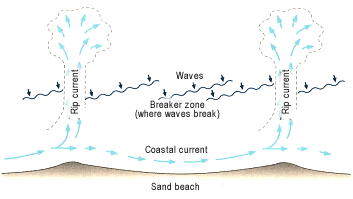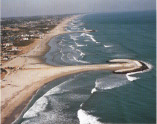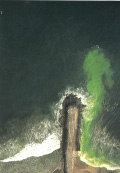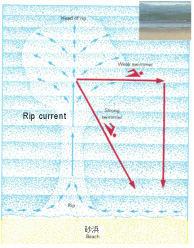Let's forestall accidents at bathing beaches!
Experiments of reproducing rip currents at the water's edge
Currents on the seashore generated by waves
The currents generated on the seashore due to the action of waves are called "nearshore currents."
Of these, the currents along the seashore (land) are called "coastal currents," whereas the currents from the seashore to offshore (from the land toward the sea) are called "rip currents."
If caught in a rip current while bathing in the sea, one could be carried out to sea and be unable to return to land.
|

Conceptual drawing of rip currents
(excerpted from "Communing with the Seashore (Sankaido)") |
Locations where rip currents are generated
Rip currents cannot be easily seen with the eye. However, the places where they occur can be recognized by closely observing the seawater, because in many cases the breaking waves are smaller than the periphery and the seawater is turbid.
Strong rip currents tend to occur on the lateral sides of coastal structures, such as jetties and headlands (Figure 2).
Dangerous spots are often designated as no swimming zones, so make sure to keep away from such zones.
|

Headland of Kashimanada

Rip current near a coastal structure
(excerpted from "Coasts in Ibaraki Prefecture" and "Collection of Q&As for Job Sites")
|

Views of investigations using dye(Click here for video clips.)
|
How to escape from a rip current
Rip currents flow faster than all but the fastest Olympic swimmers can swim (1 to 2 m/s).
Accordingly, if you are caught in a rip current and try swimming toward the shore (land), you are unlikely to reach it and will become exhausted.
If caught in a rip current, stay calm and try to swim parallel to the land to escape from the rip current (Figure 3). A rip current is typically around 20 to 30 m wide, so you can get out of it by swimming parallel to the shore for just the length of a 25-meter swimming pool.
|

Figure 3 How to escape from a rip current |
Reference book
"Communing with the seashore," a guidebook for understanding and enjoying coasts, published by Sankaido
|
|